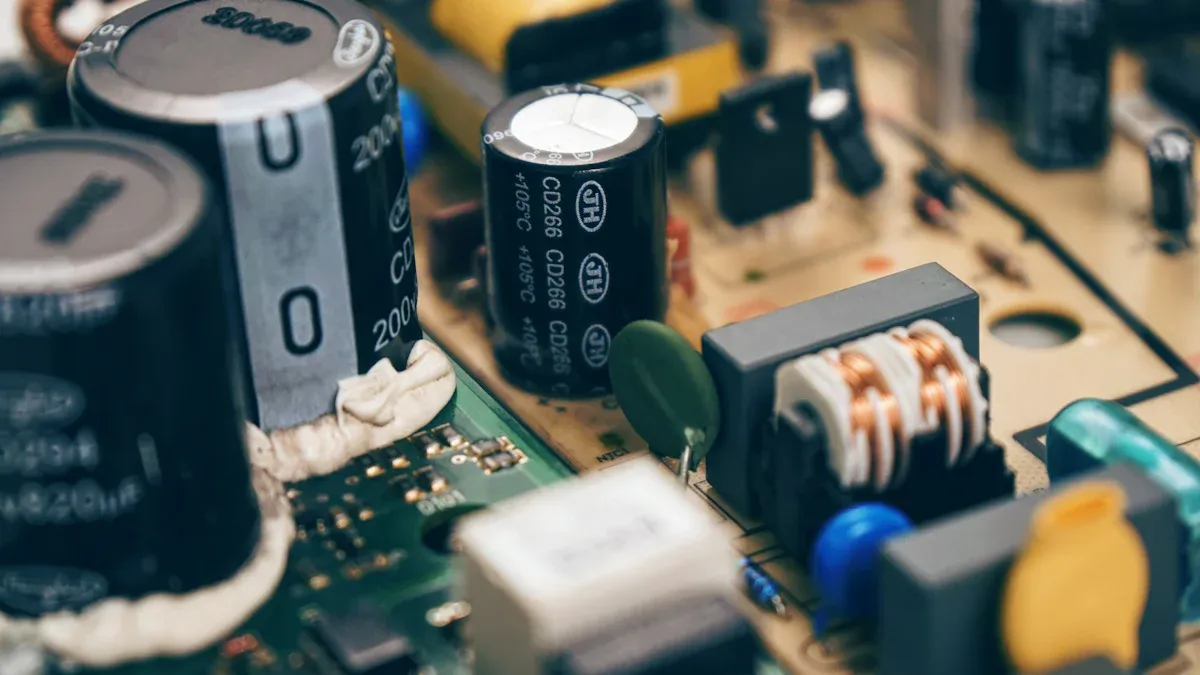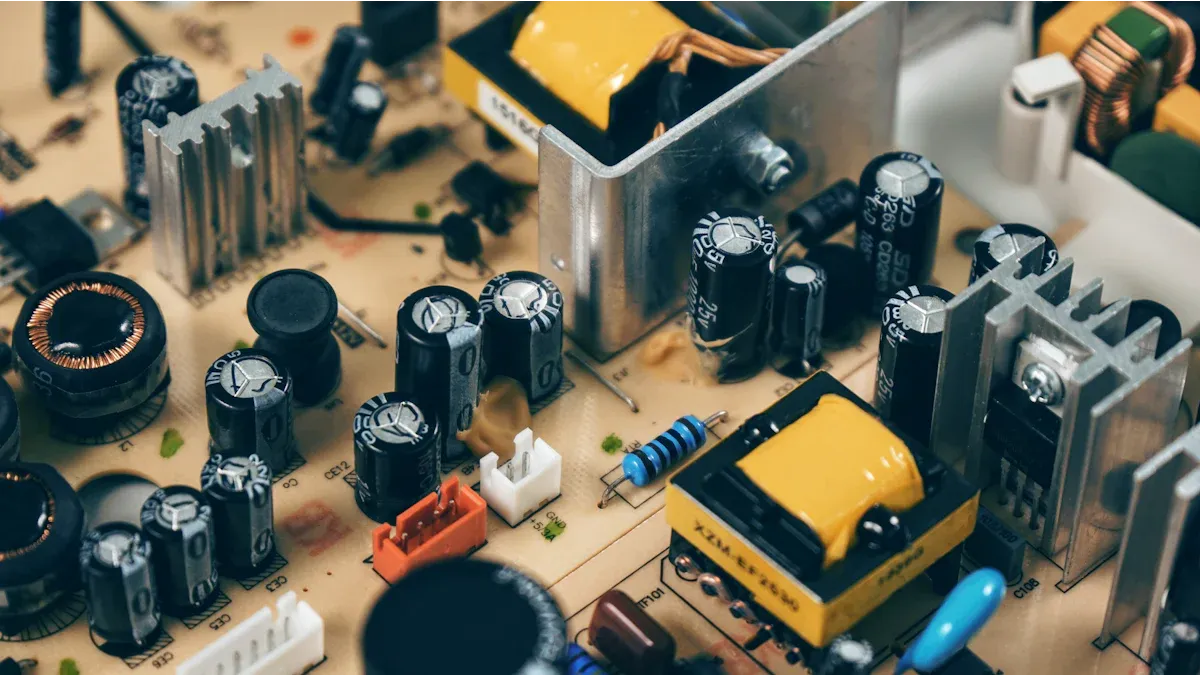Understanding Rectifiers and Their Basic Concept

A rectifier is a tool that changes alternating current (AC) into direct current (DC). This lets devices that need DC work properly. Rectifiers are used in many things, like charging phones or powering electric cars. They are becoming more important as industries use better electrical systems.
The global rectifier market may grow 10.61% yearly from 2025 to 2030 because of higher demand.
Sales of consumer electronics went up by 23.5% in 2021, showing more need for rectifiers.
By 2030, electric cars might make up 70% of all vehicle sales, increasing rectifier use.
These facts show how rectifiers connect AC power to DC devices, helping modern technology succeed.
Key Takeaways
Rectifiers change alternating current (AC) into direct current (DC). This helps devices like phones and electric cars work well.
More people need rectifiers now, and the market is growing fast. Experts say it will grow 10.61% every year from 2025 to 2030.
Full-wave rectifiers work better than half-wave ones. They give smoother and more steady DC power for delicate devices.
Diodes are very important in rectifiers. They let electricity move in only one direction, which is needed to turn AC into DC.
Rectifiers are used in many things, like power supplies, charging batteries, and renewable energy systems. They make things more efficient and save energy.
What is a Rectifier?
Definition and purpose
A rectifier changes alternating current (AC) into direct current (DC). This process, called rectification, helps devices that need steady electricity. Many gadgets, like phones and laptops, use DC power to work. Without rectifiers, these devices couldn’t run on the AC power from electrical grids.
Rectifiers have been used in electrical work for a long time. Early ones used vacuum tubes, but now we use better semiconductor devices. These new designs are more reliable and work better. Today, rectifiers are used for many things, like powering home electronics or finding radio signals. Turning AC into DC makes them very important in many systems.
Key facts about rectifiers:
They change AC into DC for devices.
They improved from vacuum tubes to modern semiconductors.
They are used in power supplies and communication systems.
Importance in electrical systems
Rectifiers are very important for handling electricity in today’s systems. They make sure devices get the right current, avoiding damage and working better. For example, in cars, rectifiers stop voltage from reversing, which could break parts. This is even more important as cars use more advanced electrical systems.
Electric cars show why rectifiers matter so much. These cars need rectifiers to control electricity between the battery and parts. Without them, electric cars wouldn’t work safely or well. In factories, rectifiers also help power big machines and tools.
Did you know? The market for car rectifier diodes shows how important they are for safety and performance. As electric cars become more common, the need for rectifiers will grow.
How Does a Rectifier Work?
Basic principle of rectification
A rectifier changes AC power into DC power. AC switches direction often, but DC flows one way. Rectifiers make sure electricity moves in one direction only. This is important for devices needing steady power. Think of it like a one-way door for electricity.
In small systems, like 3.3V or 1.8V setups, rectifiers handle up to 20A. But, this process isn’t perfect. Some energy is lost during rectification. For example:
Ultra-fast recovery diodes can lose over half the power.
Schottky diodes lose 18% to 40%, causing big energy losses.
Even with these losses, rectifiers are key for giving devices the right power.
Role of diodes in rectifiers
Diodes are very important in rectifiers. They let electricity flow one way and block the other way. This makes them perfect for turning AC into DC. In a rectifier, diodes control how electricity moves.
Different diodes, like Schottky and ultra-fast recovery ones, are used for various jobs. Schottky diodes lose less energy because of their low voltage drop. But in high-current systems, they still waste some power. Picking the right diode helps make rectifiers work better.
AC to DC conversion process
Turning AC into DC happens in steps. First, AC power goes into the rectifier. The diodes inside stop the negative part of the AC wave. Only the positive part passes through, creating a bumpy DC signal. Capacitors are added to smooth this signal.
Rectifiers and other power converters are cheap and efficient. But they can create harmonics, which lower power quality. Single-phase rectifiers work for small devices. Three-phase ones are used for big machines in factories.
New methods help improve rectifiers. For example, advanced tools measure harmonic distortion better. These updates help rectifiers meet modern technology needs.
Types of Rectifiers

Rectifiers come in various types for different uses. Knowing these types helps you pick the right one. Below are three common kinds.
Uncontrolled Rectifiers
Uncontrolled rectifiers are simple and easy to use. They use diodes to turn AC into DC without extra controls. These are great for basic devices where adjusting power isn’t needed. For example, they work well in small power supplies.
Diodes in these rectifiers let current flow one way only. This changes the AC input into a one-way DC output. But they can’t adjust the output, so they’re not ideal for systems needing precise control.
Tip: Use uncontrolled rectifiers for cheap and simple setups where efficiency isn’t critical.
Controlled Rectifiers
Controlled rectifiers are more advanced than uncontrolled ones. They use special parts like thyristors or SCRs instead of regular diodes. These parts let you control voltage and current by changing the firing angle.
These rectifiers are used in factories, electric cars, and green energy systems. They are efficient and work well in tough conditions. For example, 12-pulse rectifiers lower harmonics and improve power quality. Below is a table showing key features of controlled rectifiers:
Feature | Description |
|---|---|
Technology | 12-pulse designs cut harmonics and boost power factor, ideal for EVs and renewable energy. |
Materials | New materials like SiC and GaN improve heat handling and efficiency. |
Control Methods | Digital tools like DSPs and FPGAs allow better monitoring and adjustments. |
Modularity | Modular setups make scaling and repairs easier, improving reliability. |
Sustainability | Energy-saving designs reduce waste and help the environment. |
Did you know? Controlled rectifiers are key in EV charging stations, ensuring smooth and efficient power transfer.
Half-Wave Rectifiers
Half-wave rectifiers are the simplest kind. They use one diode to convert half of the AC input into DC. This makes them cheap and easy to design. But they waste energy by blocking half of the power.
Key points about half-wave rectifiers:
They are used in basic electronic circuits.
A single diode causes high energy loss.
Their output is uneven, making them unsuitable for sensitive devices.
Half-wave rectifiers aren’t very efficient but are useful for low-power tasks where cost matters more than performance.
Note: For smoother and more efficient DC power, try using a full-wave rectifier instead.
Full-wave rectifiers
Full-wave rectifiers work better than half-wave rectifiers. They change the whole alternating current (AC) wave into direct current (DC). Half-wave rectifiers only use part of the AC wave. This makes full-wave rectifiers a good choice for steady and reliable DC power.
How Full-Wave Rectifiers Work
Full-wave rectifiers use more diodes to handle both parts of the AC wave. A bridge rectifier, for example, uses four diodes in a special setup. This design makes current flow the same way during both parts of the AC wave. The result is a smoother DC output compared to the uneven output of half-wave rectifiers.
To make the output even better, capacitors are added. These parts lower ripple voltage, giving a more stable DC supply. This makes full-wave rectifiers great for powering sensitive devices.
Advantages of Full-Wave Rectifiers
Full-wave rectifiers have many benefits over half-wave rectifiers:
Higher Efficiency: They use the whole AC wave, doubling the output power.
Reduced Ripple Voltage: The output is smoother, helping devices work better.
Better Voltage Performance: Studies show they give higher RMS and peak voltage, making them great for steady power needs.
Comparing Full-Wave and Half-Wave Rectifiers
Full-wave rectifiers are better than half-wave rectifiers in many ways:
Harmonics: Full-wave rectifiers create fewer harmonics, improving power quality. A Bullard plot shows fewer second harmonics in full-wave rectification.
Output Voltage: Full-wave rectifiers give better voltage. Tools like voltmeters and oscilloscopes confirm their higher RMS and peak values.
Energy Efficiency: By using both parts of the AC wave, full-wave rectifiers save energy.
Applications of Full-Wave Rectifiers
Full-wave rectifiers are used in many areas:
Power Supplies: They provide steady DC voltage for electronics.
Battery Charging: They charge batteries quickly and efficiently.
Industrial Equipment: Machines use them for their high efficiency and reliability.
Tip: Use a full-wave rectifier if you need smooth and efficient DC power. It works well for both small and big systems.
By learning about full-wave rectifiers and their benefits, you can choose the best rectifier for your needs.
Applications of Rectifiers
Power supply systems
Rectifiers are key in power supply systems. They turn AC power into DC power. This gives devices the steady current they need to work. Rectifiers are found in home gadgets and factory machines. In telecommunications, special rectifiers handle changing AC inputs. This makes systems more reliable and saves money over time.
In trains, rectifiers help save energy during braking. They can recover up to 30% of lost energy. This makes trains more energy-efficient and eco-friendly. In chip-making, rectifiers keep voltage steady for precise work. Companies like Intel use them in production. Wind and solar power systems also use rectifiers. They turn AC power into DC to support the grid and improve efficiency.
Battery charging
Rectifiers are very important for charging batteries. They change AC power into DC, which batteries need to charge. Off-board chargers often use rectifiers as one-way AC/DC converters. These chargers are efficient and reduce stress on switches. But they have limits, like less control over reactive power and needing balanced capacitor voltage.
Aspect | Details |
|---|---|
Common Use | Used in off-board battery chargers |
Advantages | High efficiency, low stress on switches |
Limitations | Limited reactive power control, need for balanced capacitor voltage |
Rectifiers help charge phones, laptops, and electric cars safely. Their role in charging shows how important they are in today’s technology.
Signal demodulation
Rectifiers are also used in signal demodulation. They change AC signals into DC to extract information. This is important for radios and TVs. Rectifiers help decode sound and pictures from signals. They make sure the transmission is clear and accurate.
For example, in AM radios, rectifiers separate sound from the carrier wave. This lets you hear music or talk clearly. Without rectifiers, many communication devices wouldn’t work well. Their ability to process signals makes them essential for demodulation.
Industrial uses
Rectifiers are very important in many industries. They make sure machines get the right power to work well. Industries like factories, renewable energy, and transport depend on them. Rectifiers change AC power into DC, which is needed for many tasks.
In factories, rectifiers power tools like welding machines and motors. These tools need steady DC power to work correctly. Without rectifiers, keeping production lines precise and reliable would be hard. Rectifiers also save energy by cutting power waste, lowering costs for industries.
Renewable energy systems use rectifiers a lot. Solar panels and wind turbines make DC power, but most grids use AC power. Rectifiers turn DC into AC, so it works for homes and businesses. This helps renewable energy fit into the power grid. As more people use renewable energy, rectifiers are needed more.
Transport systems also use rectifiers. Electric trains and trams change AC from wires into DC for their motors. This keeps them running smoothly and efficiently. In electric cars, rectifiers control power between the battery and motor. This improves safety and performance.
The table below shows why rectifiers are important in industries:
Reason | Explanation |
|---|---|
More Factories and Power Plants | Higher need for rectifiers as industries grow. |
Rise in Renewable Energy Use | Rectifiers help turn DC from renewables into AC for grids. |
Better Rectifier Technology | New designs make rectifiers more efficient and reliable. |
Focus on Saving Energy | Rectifiers improve power quality and save energy for sensitive machines. |
Rectifiers are key in industrial work. They give steady power and save energy, making them vital for modern technology. Knowing how they work shows their value in industries everywhere.
Half-Wave vs. Full-Wave Rectifiers

Key differences
Half-wave and full-wave rectifiers handle AC differently. Half-wave rectifiers use only one part of the AC wave. Full-wave rectifiers use both parts of the wave. This difference affects how well they work and their output.
Feature | Half-Wave Rectifier | Full-Wave Rectifier |
|---|---|---|
Average DC Output Voltage | Lower than full-wave | Higher, about 0.637Vmax |
Ripple | More ripple, uneven output | Less ripple, smoother output |
Efficiency | Less efficient | More efficient, uses both wave parts |
Output Frequency | Matches input frequency | Double the input frequency |
The table shows how full-wave rectifiers are better. They give smoother and more efficient DC power, which is great for sensitive devices.
Efficiency comparison
Full-wave rectifiers are usually more efficient than half-wave ones. They use both parts of the AC wave, doubling energy conversion. This makes them better for steady power needs. But new studies show half-wave rectifiers can work better with certain capacitive loads. This challenges the idea that full-wave rectifiers are always better. Tests and calculations reveal half-wave rectifiers can sometimes deliver energy more effectively.
Advantages and disadvantages
Each rectifier type has pros and cons. Half-wave rectifiers are simple and cheap to make. They are good for low-power tasks where cost matters most. But their uneven output and low efficiency make them bad for devices needing stable power.
Full-wave rectifiers are more efficient and give smoother output. They are perfect for sensitive electronics and industrial tools. However, they are more complex and cost more, which may not suit basic systems.
Tip: Use a half-wave rectifier for simple tasks. Choose a full-wave rectifier for steady and efficient DC power needs.
A rectifier is important for changing AC power into DC power. This helps devices get steady electricity to work properly. There are different kinds of rectifiers, like half-wave and full-wave, each with unique uses. They are used in power supplies, charging batteries, and running machines in factories. Rectifiers are crucial for modern technology, such as electric cars and green energy systems. Knowing about rectifiers helps you see how they power the tools and systems we use daily.
FAQ
What does a rectifier do?
A rectifier changes alternating current (AC) into direct current (DC). It powers devices like phones, laptops, and electric cars. This helps them work safely and efficiently.
How do diodes work in rectifiers?
Diodes let electricity flow in one direction only. They block it from going the other way. This makes them important for turning AC into DC.
Which rectifier is best for delicate devices?
Full-wave rectifiers are best for delicate devices. They use both parts of the AC wave to give smooth and steady DC power. This reduces uneven electricity and keeps devices safe.
Do rectifiers help save energy?
Yes, rectifiers save energy. For example, trains with regenerative braking can recover up to 30% of lost energy. They also cut power waste in factories and green energy systems.
Are rectifiers used in green energy?
Yes! Rectifiers change DC power from solar panels and wind turbines into AC. This helps green energy systems supply electricity to homes and businesses effectively.
See Also
An Introductory Overview of Telecom Power Supply Systems
Exploring the Pros and Cons of Lead-Acid Batteries
Photovoltaic Inverter and Battery Systems for Telecom Cabinets
Calculating Power Systems and Batteries for Telecom Cabinets
Ensuring Correct Voltage Levels in Communication Cabinets by ESTEL
CALL US DIRECTLY
86-13752765943
3A-8, SHUIWAN 1979 SQUARE (PHASE II), NO.111, TAIZI ROAD,SHUIWAN COMMUNITY, ZHAOSHANG STREET, NANSHAN DISTRICT, SHENZHEN, GUANGDONG, CHINA

